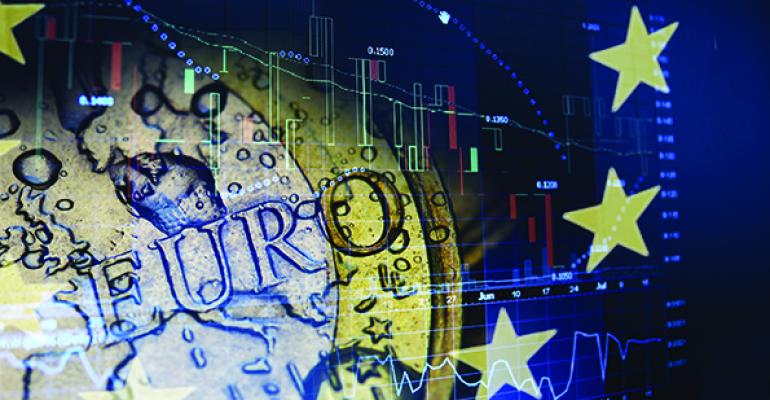Concerns over Greece’s debt repayments, rising bond yields, and the euro’s slide against the dollar are causing some short-term anguish. But if you can look deep into the heart of Europe, there are some compelling reasons for expanding portfolio positions in the continent.
There are a number of surprises in Europe that are not making the headlines. Stocks in Southern Europe still appear to be good values, despite a general run-up in European stocks over the past year. And the general continental economy still appears to be on the path to recovery.
The most robust European competitors are also fierce players in the global economy, although they get little attention because they are overshadowed by the U.S. and China. Eight of out the top-15-ranked countries for global competitiveness are in Europe, with Switzerland leading the pack, followed by Finland (fourth) and Germany (fifth), according to the World Economic Forum.
While the euro area is only expected to grow half as much as the U.S. next year—rising just above 1 percent—it’s still on the upswing, forecasts the World Bank, compared to 2011 through 2013, when the region saw negative economic growth.
What makes Europe even more compelling is that some world-class global companies have been lumped in with the continent’s many economic woes, mostly due to the hangover from the 2008 financial meltdown. Companies like Nestle SA (OTC: NSRGF), HSBC Holdings PLC (OTC: HBCYF) and Bayer AG (OTC: BAYZF) have operations on nearly every continent.
Europe-based companies offer world franchises at relatively good values and have benefited from a recently launched low-interest-rate quantitative easing program from the European Central Bank, which is buying some €60 billion ($66 billion) in government debt into 2016. The “QE” program echoes a similar Federal Reserve Bank stimulus effort that is now winding down in the U.S. Falling oil prices have also helped the energy-dependent continent pull out of its slump.
“Europe has some brilliant, world-class companies,” says Andrew Clifton, portfolio specialist for T. Rowe Price in London. “It’s still an attractive long-term investment opportunity.”
Like many portfolio managers focusing on European stocks, he still sees some attractively priced stocks in Spain and Italy, and remains bullish on the stronger economies in the U.K. and Germany.
What makes Europe look better on paper are stock valuations compared to U.S. companies. The average forward price-to-earnings ratio is around 15 for euro stocks, compared to more than 17 for U.S. corporations. And with the euro slipping against the dollar, that makes European exports even more attractive to foreign customers. That favors major exporters like France, Germany and the U.K.
“With the exception of Denmark, most of Europe looks appealing relative to the U.S.,” says John Krey, international investment analyst for S&P Capital IQ. “The ECB’s quantitative easing appears to be working. For now, things are beginning to pick up.”
Event Risk
Apart from the blossoming European growth story, though, it still pays to be cautious with the continent. It’s still far from out of the woods with Greece’s debt repayments, which serves up the largest dollop of event risk. Although the nation represents a tiny slice of the continent’s economy, the broader fear is that if the country defaults on its loans or pulls out of the euro, it could trigger a contagion, with other weak Southern European countries following suit.
There’s also some reason to be wary of the last year’s run-up in European stocks. The Global Dow Euro index climbed nearly 28 percent over the past year through May 8, compared to a 10 percent climb for the Dow Jones Americas Index. For tactical managers, it may not be the best time to jump into European stocks.
“Investors bought into the QE story and rolled over on it,” notes John Blank, investment strategist for Zacks Investments in Los Angeles. “The [German] DAX Index is near a five-year high. All of the good news is priced in.”
Blank suggests active investors should “wait on Europe, but I wouldn’t be too nervous, although Greece will still cause some fear.”
As with any region, you have to weigh recent news against long-term projections.
Looking a year or two into the future, the eurozone is forecast to show an incremental recovery spurred by rising consumer and business confidence, which “should translate into an easing of deflation fears and better growth,” reports Nuveen Investments in a quarterly investment outlook. “But Europe still faces a number of headwinds, including the need for structural reforms.”
A Broad-Based or Focused Portfolio Approach
While it’s tempting to single out the strongest economies in Europe through country-specific exchange traded funds (ETFs), it’s important to capture a broad swath of the continent in a broad-based portfolio.
Todd Rosenbluth, director of ETF and mutual fund research for S&P Capital IQ, recommends the Vanguard European ETF (NYSE Arca: VGK), which covers most of the continent through an index-based approach. The fund, charging 0.12 percent in annual management expenses, is up more than 8 percent year to date through May 12. It holds nearly one-third of its portfolio in the U.K., with the remainder in developed Europe.
For a more targeted approach to Europe’s most robust economy, S&P suggests the iShares MSCI Germany ETF (NYSE Arca: EWG), which contains some undervalued stocks. The fund charges 0.48 percent annually and is also up about 8 percent year to date. “We think Germany will remain the fastest-growing economy in the eurozone,” says Zacks’ Blank.






